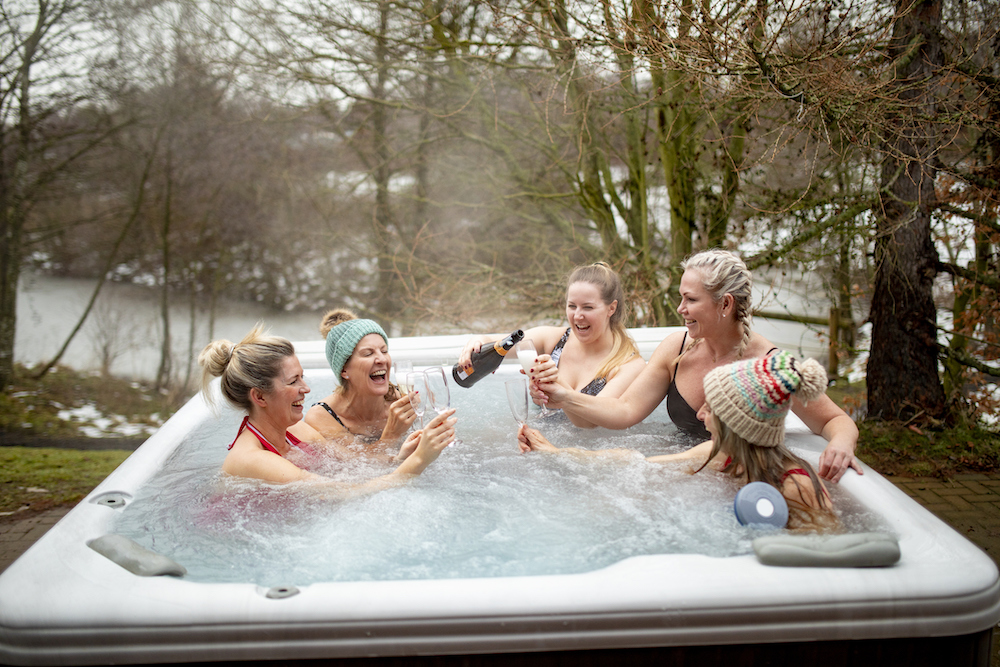

We may earn revenue from the products available on this page and participate in affiliate programs. Learn More ›
Jacuzzis—also known as hot tubs, jetted tubs, spa tubs, and whirlpools—are a familiar sight in gyms, hotels, resorts, suburban backyards, and even stretch limousines. The bubbly baths are also a pop culture staple, beginning with the 1966 flick The Fortune Cookie, finding fame as a fixture of the Playboy Mansion’s infamous Grotto, starring in several SNL skits, and making dubious cinema history with the Hot Tub Time Machine movies in 2010 and 2016.
The surprisingly interesting history of the original hot tub, however, goes back further than you might imagine.
RELATED: 11 of Today’s Best Hot Tub Brands

1900s–1920s: Immigration and Aviation
Let’s travel back in time to the early 20th century, when seven Italian brothers by the name of Jacuzzi emigrated to America, eventually opening a machine shop in Berkeley, Calif., in 1915. As all seven were mechanical engineers, Jacuzzi Brothers Incorporated entered the nascent aeronautics industry.
Their first success was the super-light Jacuzzi Toothpick Propeller, which graced the noses of WWI-era American military planes and was reportedly famed aviator Charles Lindbergh’s “prop of choice.” (One specimen now resides in the Smithsonian.)
The brothers then began constructing entire aircraft, including the world’s first enclosed-cabin monoplane. Named the Jacuzzi J-7, it was just about to land them a contract with the U.S. Mail when tragedy struck. During a final test run, the plane’s wings snapped off, sending the J-7 into a tailspin and ending in a fireball that killed all four occupants—including Giocondo Jacuzzi.
After the Jacuzzi patriarch forbade the brothers from further work in the aviation industry, they turned their collective attention from air to water. This pivot would produce irrigation systems, injector pumps, jet propulsion systems for boats, and assorted swimming pool supplies before making the Jacuzzi name synonymous with hydromassage.
RELATED: How Much Does a Hot Tub Cost to Install?

1940s–1950s: An Illness, An Invention
In 1943, tragedy threatened another family member, Candido Jacuzzi’s fourth son, Kenneth. At only 18 months old, the boy succumbed to a systemic infection stemming from strep throat that led to a diagnosis of juvenile rheumatoid arthritis. His doctor cautioned that Kenneth might not live to see age 8, but recommended hydrotherapy to help ease the boy’s joint swelling, stiffness, and pain.
Dutifully, Inez Jacuzzi drove her son twice weekly, an hour each way, to the closest hospital with hydrotherapy facilities, but soon, the agonizing commute proved too much for Kenneth.
During one trip, however, Candido inspected the hydrotherapy unit, and discovered that it was “just pumps.” Water pumps. These, the Jacuzzis knew.
Before long, Candido had developed a portable aerating pump that could be attached to any tub, the J-300. Patented in 1952, this pump would change not only young Kenneth’s life—he lived to be 75—but the entire Jacuzzi clan’s fortunes. When commercial production began several years later, marketing emphasized the J-300’s portability and therapeutic purpose, but the Jacuzzi’s destiny as a relaxing, recreational, luxury must-have of the midcentury and beyond was already manifested.
RELATED: 15 Hot Tub Deck Ideas for a Relaxing Backyard

1960s–1970s: Queens, Celebrities, and Roy’s “Roman”
First, however, the promising pump had to become bigger and better known. It got that break in the late 1950s to early 1960s, due to an enormously popular daytime TV program, Queen for a Day. This prototypical reality competition used an “applause-o-meter” to award the most pitiable of four female down-on-their-luck contestants with full-size freezers, sewing machines, cookware, and beauty products. One of the most prominent prizes? Jacuzzi pumps to let these newly crowned queens bubble their troubles away right in their own homes.
It was a Mad Men-era marketing coup, given that Queen for a Day reached millions of daily viewers. The fact that top-tier celebrities like Jayne Mansfield, Elvis, and Marilyn Monroe all owned Jacuzzi products didn’t hurt, either.
Taking the next step toward water’s whirled domination, third-gen family member Roy Jacuzzi created “the Roman” in 1968. This self-contained unit with integrated jets replaced the J-300 with its “bring-your-own-bathtub” limitation.
Despite requiring more room, the Roman, and two even more spacious successors released in 1969 and 1970, showed the Jacuzzi’s promise—as a family activity, a health club amenity, an irresistible attraction for tired travelers, an evening’s post-fondue entertainment, an outdoor oasis, and eventually even a status symbol for swingin’ singles.

1980s–1990s: Canoodling in Champagne
As for couples? They were increasingly headed to romantic resorts in Pennsylvania’s Poconos region. These properties had flourished since the post-war marriage boom, but they got another boost thanks to the kitschy creations of one Morris B. Wilkins, owner of Caesars Cove Haven. The enterprising hotelier, who’s also credited with creating the “Honeymoon Capital of the World” moniker, had made hospitality headlines in 1963 by installing bright red, heart-shaped “sweetheart” tubs.
In the mid-80s, Wilkins debuted the 7-foot tall Champagne Whirlpool Glass-for-Two, offering lovebirds the chance to get up-close and carbonated in a colossal champagne coupe. Champagne Tower Suites featuring the singular bubbly spa baths were in such demand that canoodling couples would book stays a year in advance.
Today, heart-shaped tubs remain a popular amenity among Poconos-area hotels, and Champagne Tower Suites are still available at the three Cove Haven Resorts properties.
But, why travel to a hot tub when you could travel in one? Toward the end of the 1990s, Jacuzzis made yet another splash when they started rolling in super-long, ultra-swank limousines. Along with extras like multiple televisions, VCRs, CD players, wet bars, sunroofs, and even “cellular telephones,” these whirlpools-gone-wild helped stretch limo fees to $200-plus per hour.
